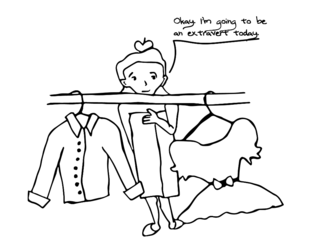
Extroversion
The Majority of People Are Not Introverts or Extroverts
Introverts and extroverts exist, but they're exceptions and face disadvantages.
Posted October 6, 2017 Reviewed by Davia Sills
The terms "introvert" and "extrovert" were devised by Carl Jung in the 1920s. They've since adopted a prominent, if not undying, life of their own. They're the cornerstone of Myers-Briggs personality inventory and one of the Big Five traits. Most simply, Jung conceived of introverts as drawing energy from being alone, while extroverts draw it from their surroundings and relationships.
But Jung himself conceded, "There is, finally, a third group, and here it is hard to say whether the motivation comes chiefly from within or without." In Psychological Types, Jung wrote that this third group is "the most numerous and includes the less differentiated normal man." In other words, Jung believed that introverts and extroverts are minorities.

Research supports this idea, increasingly pointing to the existence of "ambiverts"—people with balanced, nuanced personalities composed of both introverted and extroverted traits.
In a Wall Street Journal interview, psychologist Adam Grant estimated that ambiverts make up between a half and two-thirds of the population. This is good news, because ambiverts win at life and business.
The research-based "ambivert advantage" explains how these individuals combine the best of both sides. In one of several such studies, ambiverts achieved higher sales productivity than introverts or extroverts—in some cases, twice as much. Because ambiverts can listen as well as assert themselves, they're ideal salespeople, co-workers, business owners, and leaders.
To be sure, diehard introverts and extroverts do exist, but they're exceptions, and they may be worse for it. In fact, such extreme leanings could be the result of what psychologist Carol Dweck calls a "fixed mindset."
Over several decades, research by Dweck and others has differentiated between a growth mindset (believing you can cultivate your qualities and personality with effort) and a fixed mindset (the conviction that you have a set amount of intelligence or talent, a fixed personality, and an immutable character).
A recent study positioned a fixed mindset as "self-as-story": You believe you're a certain way; that's just how you are. It's the story you tell yourself about you. The study explained, as an example, that "a person who conceptualizes themselves as introverted may have difficulty recognizing or remembering their own extroverted behavior, or they may avoid potentially stressful social situations and come to live in an increasingly insular world."
After taking some personality tests in college, I decided I was an introvert. But then I noticed that the more I saw myself as an introvert, the more introverted I became. At 18, I thought I was the life of the party. By 25, I had almost convinced myself that I was psychologically incapable of speaking in public.
"Self-as-story" tendencies are associated with reduced well-being, particularly if those self-conceptualizations are negative. Fixed mindsets are correlated with reduced performance, as well as lower self-esteem, creativity, resilience, and self-awareness.
Still worse is that these stories about ourselves aren't true.
The uncovering of ambiverts is part of a larger investigation suggesting that healthy personalities are situational; some experts even think personality is a myth. We're inconsistent. We change more than we think we will, depending on what happens. There may be no permanent, fixed "me" to expose, introvert or extrovert.
Research shows that we feel how we act—when we smile, we feel happier—and that we act how we believe (if we believe we're introverted, for example, we act that way). These are adaptive, evolutionary responses. The problem is when our beliefs are based on the results of one-off, multiple-choice personality quizzes, and not our everyday reality.
We don't need to understand ourselves so much as we need to understand our situations. We need to ask, "Does this meeting call for sitting back, listening, and taking notes like an introvert would, or does it require confidence, assertiveness, and charisma like an extrovert would display?" Or, "How can I combine the two approaches here effectively?"
Ambiverts recognize that identifying with one trait exclusively is exhausting. You probably do, too: Recall a situation in which you had too much of what your introverted or extroverted personality stereotypically wants. Jung quipped that anyone who was truly 100 percent extraverted or 100 percent introverted would be a "lunatic."
We need both. We are both.

Of course, people's personalities differ. We repeatedly learn this. But the ongoing introvert/extrovert debate has had a polarizing, restrictive effect on our potential to see and accommodate what a given scenario needs—or even what we need. Over time, our success shrinks to a minute sphere of what we imagine that our personality types can "handle."
If we resist the labels that others try to pin on us, why do we give them to ourselves?
Hopefully continued research on ambiversion and situational personality can shed light on what introversion and extroversion really are—self-limiting beliefs.



